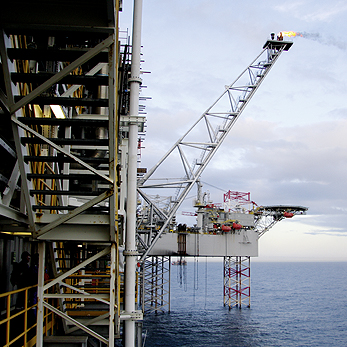How does this affect the quality status?
Areas affected by contaminated drill cuttings have reduced
Based on the collected evidence, environmental conditions around many installations have improved, especially in Region II. This Region had high, but very localised, impacts throughout the 1980s and 1990s. After further restrictions in use and discharge of organic-phase drilling fluids in 2001, monitoring at Danish, Netherlands’, Norwegian and UK rigs has shown that sediment oil concentrations have reduced significantly and that the benthic fauna have started to recover.
The Ekofisk field in the Norwegian sector is an example of a mature production site which has been in operation since the early 1970s. The restrictions in use and discharge of oil-based drilling fluids and the recent decline in oil and gas activities at the site have resulted in reduced discharges and decreasing sediment concentrations of oil and barium (from barite). This has led to a clear recovery of the sediment dwelling animal communities; the area disturbed fell by 85% to less than 20 km2 between 1996 and 2005. In contrast, areas impacted by oil and barium sulphate and with disturbed benthic fauna are still increasing at younger oil and gas production sites.
Areas contaminated by cuttings piles have also been reduced through natural erosion and because the oil leaching rate is now lower than when the cuttings were first deposited. Possible releases of oil and chemicals from old cuttings piles that are physically disturbed do not appear to be causing increased impacts on the environment.
Water column monitoring shows mostly low biological response
Water column monitoring to determine possible effects from polycyclic aromatic hydrocarbons (PAHs) and other chemicals such as alkyl phenols discharged with produced water has been carried out to a limited extent in the OSPAR area.
Monitoring in the Netherlands’ sector has shown that caged blue mussels accumulate the PAH naphthalene up to 1000 m from a platform. Water column monitoring in the Norwegian sector began in 1999 and has shown that caged blue mussels exposed to produced water discharges accumulate PAHs from the surrounding seawater. These concentrations decreased with increasing distance from the point of discharge. Levels of biological responses in caged mussels showed similar gradients to those for contaminant concentrations.
Concentrations of PAHs and alkyl phenols and measured biological responses in wild fish such as cod and haddock caught in the vicinity of offshore installations from Norwegian waters in 2002 and 2005 showed a mixed pattern mostly with no increased concentrations, but some elevated biological responses suggesting past exposure.
The results from water column monitoring are complex to interpret, particularly for wild fish for which it is not possible to link observed biological responses to a specific exposure source. Monitoring data are limited and do not yet allow conclusions to be drawn on the significance of the observed biological responses for marine life and ecosystems.
Recovery from physical impacts may be longer for sensitive species
Temporary physical impacts are caused when structures like platforms and pipelines are first put in place. These temporary physical impacts are more extensive than the long-term impacts of the structure. Disturbance from trenching and/or burying pipelines is greater than when pipelines are just laid on the seabed. Temporary impacts usually occur between 5 and 10 m from the pipeline, although this is influenced by size of the pipeline, sediment type and trenching method.
Creating hard substrates such as pipelines, platform legs and subsea templates in soft-sediment areas provides shelter for fish and other mobile marine organisms, but alters the benthic communities by providing settling areas for hard-substrate communities.
Potential environmental impacts vary across the OSPAR area, depending on differences in bottom topography, geology, water mass movement and biology. Recovery may take longer for sensitive species and in deeper and colder waters. Soft-bottom fauna can recolonise within a year or two, especially in shallow waters with a sandy/muddy seabed.

